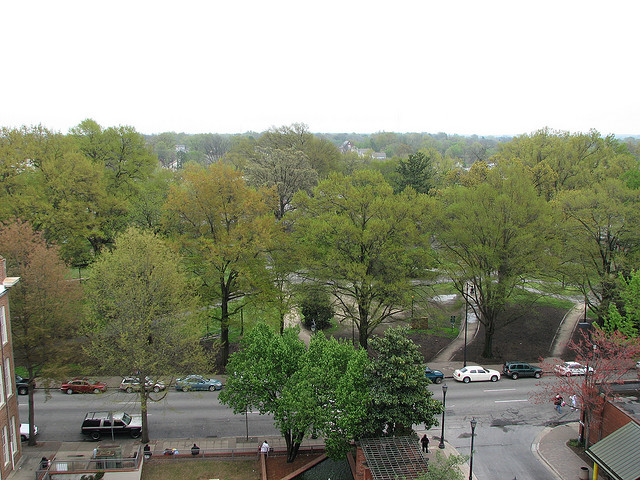Plans to renovate Moore Square in the next few years are intended to improve and save the space for generations to come. But according to a report from the Raleigh Tree Conservation Task Force, the renovations will kill off the square’s greatest treasure — the trees.
City officials approved a master renovation plan for Moore Square in May. The plan calls for keeping all of the square’s healthy trees. Only two of the square’s 73 trees are in poor condition. Thirty of those healthy trees are more than 20 inches in diameter.
But in a report last month, the task force questioned the effect the elements of the plan will have on the trees, not to mention the construction work necessary to transform the four-acre square.
“We are concerned that most of trees that are selected to remain will be lost within 10 years,” said Ted Shear, a member of the Raleigh Tree Conservation Task Force.
The problem lies underneath the ground. A tree’s root zone extends horizontally from the tree for a distance at least equal to the tree’s height. One tree advisory Web site recommends preserving at least 50 percent of the root system to maintain a healthy tree.

Right now, beds of mulch cover 25 percent of Moore Square, protecting tree root systems from the impact of trampling feet and equipment.
According to the minutes from the task force’s May 3 meeting, “If the plan requires extensive changes to most/all sides of a tree’s critical root zone, it is not likely the tree will survive. The nearby actions related to the construction process is often just as damaging to a tree’s root zone as the actual new work on the root zone.”
Chris Counts, the lead designer on the Moore Square plan and winner of the juried competition to renovate the square, said he shares the task force’s concerns about damaging tree roots. But, Counts said, how to protect existing trees will be worked out as the design process moves forward.
City law requires no disturbance to the “critical root zone” of trees marked for preservation. The size of the critical root zone depends on the tree size. Moore Square is state-owned land, so any changes do not have to comply with city ordinances. To some, that should not matter.
“The city should do at least what it makes every private developer do,” said Shear, also an associate professor in NC State’s Department of Forestry and Environmental Resources.
The Moore Square Master Plan mentions tree roots, but many of the proposed structures will be built “well into the root zones,” the report said.
The plan proposes a pier system of elevated walkways for part of the square to prevent root trampling, but in other areas granular terraces will be built. The report said such a soft surface will not prevent soil compaction that can harm tree roots.
“It is unfeasible to retain the trees and add all the programming elements,” the report said. “The City of Raleigh must choose between these programming elements and the existing trees.”

by Leo Suarez
Shear said as the plan stands, all of the critical root zones will be impacted.
“There will need to be some undisturbed area to save a few of the existing trees; there is no such area in the Master Plan,” he said.
“Most of the trees in Moore Square will not survive these impacts for more than a few years,” the report said.
Shear said there are techniques to prevent disturbance, including laying down mats to drive on, elevating walkways, tunneling under tree roots for utilities, and, in some circumstances, even excavation of soil around roots by air. The task force has requested a mitigation plan, including an evaluation of heavy equipment used near the trees.
Bartlett Tree Company, the designated arborist for the Master Plan, was not involved in the planning. The company did not provide an analysis of the plan’s effect on trees, “a critical step in Master Plan development that was skipped,” the report said.
“[Bartlett’s] role will be to do what it can to minimize damage to the trees during construction,” the report said. “This is not a process that engenders confidence that trees will be adequately protected.”
Bartlett Tree Experts referred questions to Master Plan designer Counts.
“It’s very important to protect the trees in good health,” he said.
Counts said that while valid, the concerns may be premature.
“The most important thing to remember is where we are in the process,” he said. “What we are starting to get into is the next conversation about the specific details. They’re all good questions; we’re just not there yet.”
City Project Manager Cassie Schumacher-Georgopoulos said there will be time to iron out the plan details and find ways to ensure construction does not impact the trees.
“We’re aware of the concerns and we share those concerns with the public,” she said.
The next phases of the renovation include a revised scope sometime in July or August. Schematic designs will follow, and all of it will be available for public review and public comment both in hearings and during regular city council meetings.
Some people have also questioned the inconsistency of the plan. For example, language in the plan highlights an open view through the park, but plans included a perimeter wall and an elevated lawn mound.
Counts said he looks forward to addressing the inconsistencies. He said he expects the original design to evolve as the details of the plan are specified.
“I think it will change for the better … and respond more specifically to a wide range of concerns,” he said.
